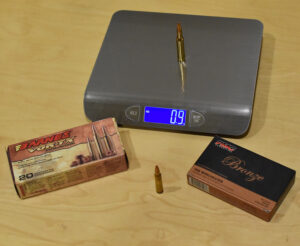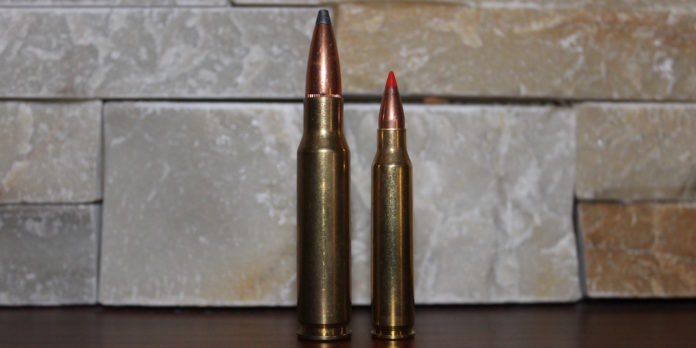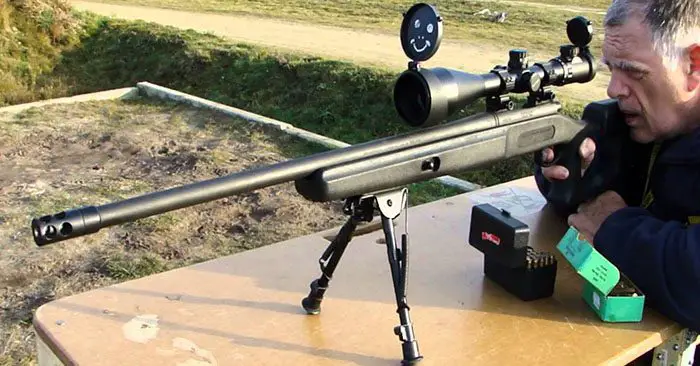On a subject like this, there is an awful lot of conjecture. You find that many people have opinions but very few have factual data to support those opinions.
Of course, either of these would be great rounds to stockpile. I think this article offers some insight that will help you decide. Which weapons you choose is a big deal because you only have the option to carry so many.
The same can be said for rounds. When you are in a well-stocked shelter you have options. But the moment you decide it’s time to bug out things change drastically.
End of the day this is your decision. Let’s look at three things to consider when looking at ammo choice.
First, lets start with the areas where the .223 Remington and .308 Winchester are similar.
Both cartridges got their start in the time period between World War II and the Vietnam War when the US Military was searching for a replacement to the venerable M-1 Garand rifle and .30-06 Springfield cartridge. Each cartridge has also been used extensively by military forces all over the world, including the US Military and the armed forces of many other NATO members.
For this reason, there’s a pretty good supply of surplus military ammo for both cartridges (though .308/7.62 surplus ammunition is not as common or inexpensive as it was 20-30 years ago).
The two cartridges also have great reputations for accuracy and are very popular among competition shooters all over the world. Shooters, hunters, and preppers use both cartridges extensively, so just about every major gun manufacturer produces rifles chambered in .223 Remington and .308 Winchester.
Indeed, the .223 Remington and .308 Winchester rank right up there with the .270 Winchester and .30-06 Springfield at the top of the list of the most popular centerfire rifle cartridges in the United States. Not surprisingly, users of these cartridges have plenty of choices when it comes to good quality guns as well as surplus military, target shooting, and hunting ammo.
So, we’ve covered how the .223 and .308 are similar, but how are they different?
223 vs 308: Cartridge Sizes
Though the US Military was pleased with the performance of M-1 Garand and the .30-06 during World War II, American military leaders started looking for a new rifle and cartridge in the years following the war. Specifically, they wanted a rifle capable of fully automatic fire and with a detachable magazine along the lines of the German StG-44 or the Soviet AK-47. At the end of a long and contentious design and selection process, the Army eventually picked the M-14 rifle chambered in the new 7.62x51mm cartridge to replace the M-1 Garand.
The original M80 ball load for the 7.62x51mm NATO fired a .308″ 147 grain full metal jacket (FMJ) bullet at 2,750 feet per second (2,469 foot pounds of energy). This load had virtually the same ballistics as the original .30-06 Springfield load (150 grain bullet at 2,700 feet per second), but due to advances in powder technology, the 7.62x51mm cartridge achieved that same level of performance while using a much shorter case (51mm vs 63mm).
Range
What is the range of .223?
The .223 ranges is effective from 400 to 600 yards but with less energy and knock down power than the .308, the .223 is more useful at shorter ranges. With the advancements in cartridge innovation, the .223 can reach out to 1,000 yards.
Since the .223 has a lighter recoil than the .308, this may be the thing to have if your hunting situations requires lots of follow-up shots like feral hogs control.
What is the effective range of a 308?
In the military the US Army emphasizes an 800 meter maximum effective range for the .308, the Marine Corps preaches a 1000 yard (915 meter) max effective range. For most hunt you won’t have to shoot at these ranges but at 400 and beyond you’ll be able to bring down the big game without a hitch.
In summary the flat trajectory and lightly constructed bullets most common with the .223 Remington make it great for taking shots at small, thin skinned animals like prairie dogs, bobcats, and coyotes.
The .308 on the other hand shoots heavier, larger diameter, better constructed bullets, and the .308 Winchester has a clear advantage when hunting larger species like deer, caribou, elk, and red stag. The .308 may be light for moose and grizzly/brown bear, but it will work with good shot placement.
Home Defense & Target Practice
When it comes to home defense the .308 cartridges is suitable for its stopping power. Even if you go with the .223 there are many good semi-auto rifles with quality ammunition available at a reasonable price.
.308 – Using this heavy round for home defense is kind of expensive and not the thing to consider. But if your purpose is for target practice and you compete as an F-Class shooter, then you’ll be going through rounds by the thousands per month. For a quick tip on choosing the bullet weight consider what your barrel twist rate is, here’s a quick guideline:
- 1:15 twist: up to 150 grains
- 1:14 twist: 150 – 168 grains
- 1:12 twist: 168 – 170 grains
- 1:10 twist: 170 – 220 grains
- 1:8 twist: 220 grains or more
Energy Advantage: .308 Winchester
.223 vs. .308 Bullet Trajectory
Because it has a lighter bullet and faster speeds, the .223 Winchester usually maintains a flatter trajectory. For example, Federal Premium’s American Eagle 55-grain FMJ-BT cartridge, when zeroed to 100 yards, drops 2.7 inches after 200 yards. At 300 yards, it drops 10.9 inches. The same product in a .308 Winchester with a 150-grain FMJ-BT bullet drops 3.6 inches after 200 yards and 13.5 inches after 300 yards. It’s not a large advantage, but it’s enough to make a noticeable difference in long-range shots.
Trajectory Advantage: .223 Remington
Affordability
Pricing depends not only on what you buy, but also where and how you purchase. Generally speaking, however, you will find that the .223 Remington has a slight advantage when it comes to pricing. However, neither one of these cartridges is overly expensive, so you should be able to enjoy an affordable day at the range with either choice.
Price Advantage: .223 Remington
Compatibility
Another big thing to consider is what do the other people you associate with carry? More important than the caliber you choose is the compatibility you have with people in your group or mag. If you find yourself in a gunfight protecting the perimeter or on security detail, you want to be able to both give and receive ammo.
Be sure you are not the guy with the obscure round or you will be the guy with no ammo.
Portability & Mobility of the Rifleman

The typical .308 rifle should weigh somewhere around 8-pounds to help properly absorb recoil from ammunition loaded with a bullet that’s two to three times heavier than what you’ll find in a 6-pound .223-chambered rifle.
But it’s not just the rifle. It’s also the ammunition.
.308 ammo weighs some where around .9 oz per round. .223 comes in at about half that rate. Sure, that’s nothing when you’re looking at just a single cartridge or even a single magazine. But think about what that sort of weight differential does to you if you are bugging out or expected to be on the run with your rifle for days at a time.
If you think of yourself as a carrier with fixed carrying capacity you’re going to have a lot more rounds of .223 you can bring with you. For instance, if your ammunition “carry budget” is 10 pounds, you’ll be able to bring about 185 rounds of .308 ammo with you. Or, you could bring somewhere around 400 rounds of .223.
Mobility Advantage: .223 Remington
Choose the .223 Remington if…
If you are interested in high-volume target shooting, small to medium-game hunting, or long-distance shooting, you will likely want the .223 Remington. The cartridge is affordable and almost always available at your nearest sporting goods store. It also gives tight grouping, which is essential for hunting smaller game.
Choose the .308 Winchester if…
If your goal is to pursue medium and large-sized game animals, you will be happier with the .308 Winchester. You can certainly use this cartridge for target shooting and other hobbies (but certainly not small game), but it is most effective for sports like deer hunting.
No matter which is right for your needs, you’ll have a reliable cartridge that is trusted by competition shooters and hunters all across the nation.




